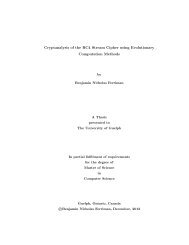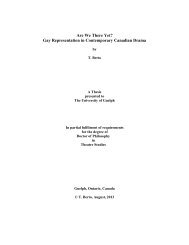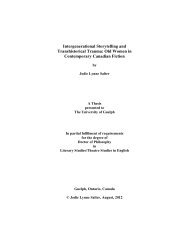University of Guelph thesis template - Atrium - University of Guelph
University of Guelph thesis template - Atrium - University of Guelph
University of Guelph thesis template - Atrium - University of Guelph
Create successful ePaper yourself
Turn your PDF publications into a flip-book with our unique Google optimized e-Paper software.
following years, although becoming somewhat obscured by 1885 when rag carpet orders<br />
comprised 38% <strong>of</strong> his business.<br />
How does category clustering work on an individual basis? Donald Graham from Lobo<br />
Township opened his account on February 21, 1861 with the purchase <strong>of</strong> 27 yards <strong>of</strong> bordered<br />
blankets. Eight months later, on October 11 he made another order for 22 ½ yards <strong>of</strong> full cloth.<br />
Both orders were paid in full on March 5, 1862. Donald Graham’s order for 22 ½ yards <strong>of</strong> full<br />
cloth in 1861 was the fifth <strong>of</strong> 30 orders for full cloth. Between August 8, 1861 and December<br />
30, 1861, Campbell took orders for 536 ½ yards <strong>of</strong> full cloth which were mostly paid in full<br />
between February and March <strong>of</strong> 1862 (Appendix 1.13). 168<br />
Repeat customer Sylvester Campbell<br />
from Lobo Township began his 1861 account on July 2, 1861 by ordering two carpet coverlets.<br />
His account still open, he returned in November and then December to make two orders for full<br />
cloth and then closed his account on February 8, 1862 on the same day that he ordered 28 yards<br />
<strong>of</strong> 4-colour stripe. In any case, I believe that orders for full cloth and other types <strong>of</strong> cloth were<br />
clustered around a specific time period, not by accident but by design, most likely pointing to<br />
production schedule that was efficient for Campbell and kept costs down for customers.<br />
Campbell produced some cloth that only appeared once or very few times in the account<br />
book. The following six types <strong>of</strong> cloth were only produced once: shepherd’s plaid, kersey,<br />
diaper, linen, quilt and scarlet flannel. 169<br />
From a technical point <strong>of</strong> view, these textiles are<br />
interesting to consider, and confirm Campbell’s versatility as a weaver and his willingness to<br />
meet his customers’ needs but do not show the major trends <strong>of</strong> his production. These more<br />
168 In a minority <strong>of</strong> cases, the date <strong>of</strong> final payment does not appear to fit this pattern. For example, Malcolm McKeller, Caradoc<br />
Township ordered full cloth November 6, 1861 and made final payment on November 15. Mrs. Carrey, Delaware Township<br />
ordered full cloth on November 7, 1861 and made final payment on November 18, 1861.<br />
169 See the Glossary for a definition <strong>of</strong> these fabrics.<br />
98
















